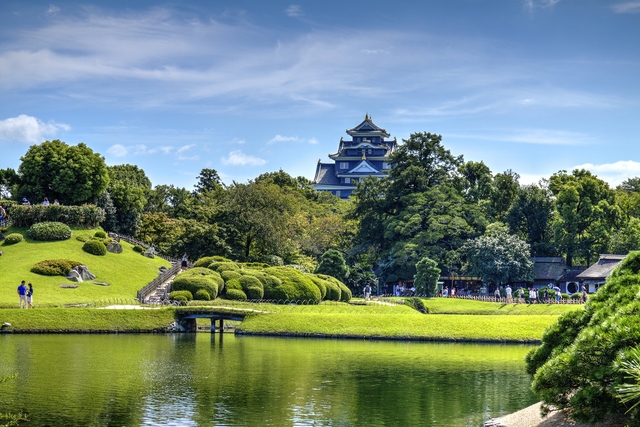
The Scenery That Japan Boasts to the World! How to Enjoy the Three Great Japanese Gardens
Japanese gardens, where Japan's unique aesthetic sense can be experienced, are full of photogenic spots! This article will showcase the highlights of the three most popular gardens in Japan.
This post may contain affiliate links. If you buy through them, we may earn a commission at no additional cost to you.
What Are the Three Great Japanese Gardens?
Before introducing each garden, let\'s start from the basics!
The Three Great Gardens of Japan is the name given to three famous gardens: Kairakuen in Mito (Ibaraki Prefecture), Kenrokuen in Kanazawa (Ishikawa Prefecture), and Korakuen in Okayama (Okayama Prefecture). All these gardens have some common features, such as the fact that they were originally the property of a daimyo (feudal lord) during the Edo period (1603 - 1868), and the fact that they were all built around a central pond.
All these ponds have a path that go around them, and a stroll on these paths can show you different sides to the garden from various angles.

1. Kenrokuen and Its Mystical Snowy Landscape
The first garden is Kenrokuen, famous for its snowy landscape. Winter in Kanazawa is extremely cold and, for this reason, the technique of yukitsuri (installing ropes to support the tree branches and prevent them from breaking due to the heavy snow) is used in the garden when winter approaches. The orderly and harmonious beauty of the yukitsuri and the endless snow falling and piling up are the main highlights of Kenrokuen!
Other than the snowy landscape, the garden has many other charms throughout the year, such as the cherry blossoms or autumn leaves being reflected on the shiny surface of the lake, the yukitsuri ropes that sparkle gold when illuminated at night, and much more.
Access: If taking a bus from JR Kanazawa Station, get off at Kenrokuen-shita, Hirosaka, or Dewamachi. Can be accessed in around 10 minutes with a taxi.
Entrance Fee: Adults (18 years or older)/310 JPY, Children (from 6 to under 18 years old)/100 JPY



2. Kairakuen, Where the Japanese Plum Blossom Aroma Hangs in the Air
If you want to go to Mito\'s Kairakuen, try going in early spring, when the Japanese plum trees bloom. You will undoubtedly be overwhelmed by the countless plum trees in full bloom!
Approximately 3,000 Japanese plum trees of 100 kinds grow in the 130,000 sq.m. large garden, and they all reach their peak between mid-February and late March. The eye is usually drawn to their beautiful appearance, but do not forget to enjoy the other big charm of the plum blossoms, their aroma. If you touch a plum branch gently, being careful not to break it, and bring your face close to the flowers, you will be able to smell a faint sweet aroma.
Every year during the plum blossom season, the Mito Plum Festival takes place and events such as koto musical performances and tea ceremonies are held in the garden, which is illuminated with decorative lights at night from early to mid-March.
Access: From the Joban Line, get off at Mito Station and board the Kairakuen-bound bus from Mito Station\'s North Exit (around 20 minutes)
Entrance Fee: Free (Kobuntei House inside the park: Adults/200 JPY, Children/100 JPY)


3. Korakuen and Its Historical Atmosphere
Korakuen in Okayama has been awarded three stars by the Michelin Green Guide Japan. It has a long history that dates back to 300 years ago, when the 2nd daimyo of the Okayama Domain, Ikeda Tsunamasa, ordered it to be built as a "peaceful place" for him. After that, the garden was damaged by flood and war. It was, however, rebuilt according to illustrations from the Edo period (1603 - 1868), and now its appearance, very similar to the one at the time, can still be enjoyed.
When visiting Korakuen, which has many highlights, the Yuishinzan Hill and the Renchiken are a must-see! The Yuishinzan Hill, which makes the garden appear three-dimensional, is an ideal photo spot where Okayama Castle can also be admired in the background. When overlooking the garden from the top after a short walk, an interesting scenery unfolds, created by the paths that seem to divide the lake in sections.
On the other hand, the Renchiken is told to be the building that Ikeda Tsunamasa preferred to use the most. It is not possible to visit it without authorization, but it is a building with a great appearance even just from the outside, with its round windows, thatch roof, and a stone bridge. In the adjacent Sazanami Tea House, it is recommended to drink matcha or eat kibi dango, the local specialty, while enjoying the scenery!
Access: 25 minutes on foot from JR Okayama Station. If using the bus, board the bus from bus stop number 1 at the bus terminal of the Korakuen Exit (East Exit) of JR Okayama Station, and get off at Korakuen-mae (10 - 15 minutes)
Entrance Fee: Adults (from 15 to 64 years old)/400 JPY, High School Students and Under/Free, Seniors (over 65 years old)/140 JPY


The Three Great Japanese Gardens, where the Japanese sense of beauty can be thoroughly enjoyed, are definitely locations that should be visited by foreign tourists coming to Japan! Using this article as a reference, take a stroll inside one of these Japanese gardens and savor the beauty of nature from season to season.
The information in this article is accurate at the time of publication.



